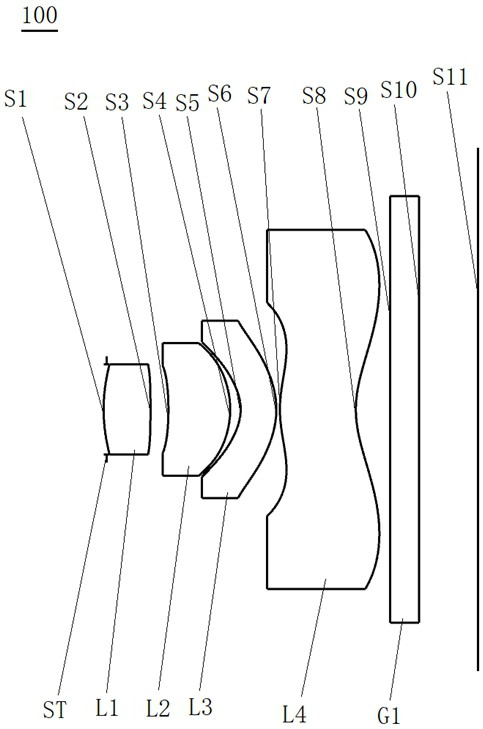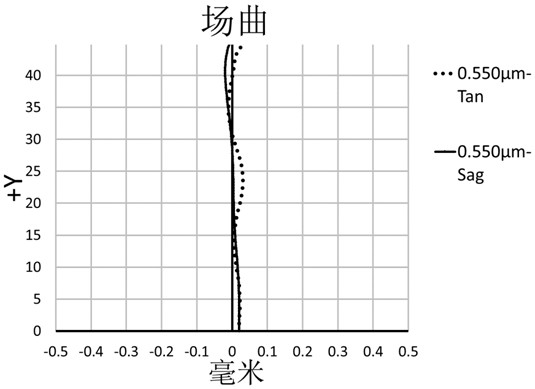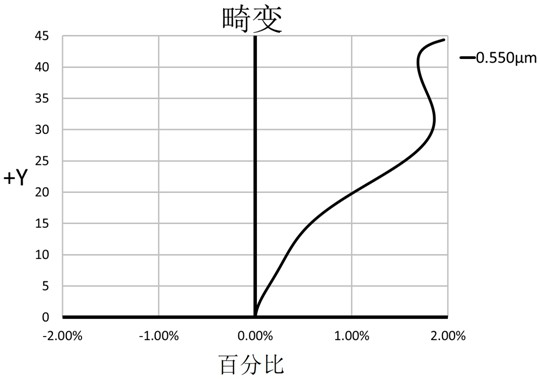Optical lens and imaging equipment
An optical lens and imaging surface technology, applied in the field of imaging lenses, can solve the problems of not being able to bring visual experience to consumers, the size of the front camera head is large, and the screen ratio is difficult to increase, so as to meet the needs of high screen ratio, Small overall length, reasonable setting effect
- Summary
- Abstract
- Description
- Claims
- Application Information
AI Technical Summary
Problems solved by technology
Method used
Image
Examples
no. 1 example
[0079] see figure 1 , which is a schematic structural view of the optical lens 100 provided in the first embodiment of the present invention, the optical lens 100 includes in sequence from the object side to the imaging surface along the optical axis: a stop ST, a first lens L1, a second lens L2, a second lens L2, Three lenses L3, a fourth lens L4 and a filter G1.
[0080] The first lens L1 has a positive refractive power, the object side S1 of the first lens is a convex surface, and the image side S2 of the first lens is a convex surface;
[0081] The second lens L2 has positive refractive power, the object side S3 of the second lens is concave, and the image side S4 of the second lens is convex;
[0082] The third lens L3 has negative refractive power, the object side S5 of the third lens is concave, and the image side S6 of the third lens is convex;
[0083] The fourth lens L4 has positive refractive power, the object side S7 of the fourth lens is convex at the near optic...
no. 2 example
[0093] For the structural schematic diagram of the optical lens 200 provided in this embodiment, please refer to Figure 6 , the structure of the optical lens 200 in this embodiment is substantially the same as that of the optical lens 100 in the first embodiment, the difference mainly lies in the design parameters.
[0094] The relevant parameters of each lens in the optical lens 200 provided in this embodiment are shown in Table 3.
[0095] table 3
[0096]
[0097] The surface coefficients of each aspheric surface of the optical lens 200 in this embodiment are shown in Table 4.
[0098] Table 4
[0099]
[0100] In this embodiment, the curves of field curvature, distortion, axial point spherical aberration and lateral chromatic aberration of the optical lens 200 are as follows Figure 7 , Figure 8 , Figure 9 and Figure 10 shown by Figure 7 to Figure 10 It can be seen that the curvature of field is controlled within ±0.05mm, the optical distortion is control...
no. 3 example
[0102] For the structural schematic diagram of the optical lens 300 provided in this embodiment, please refer to Figure 11 , the structure of the optical lens 300 in this embodiment is roughly the same as that of the optical lens 100 in the first embodiment, the difference mainly lies in the design parameters.
[0103] The relevant parameters of each lens in the optical lens 300 provided in this embodiment are shown in Table 5.
[0104] table 5
[0105]
[0106] Table 6 shows the surface coefficients of each aspheric surface of the optical lens 300 in this embodiment.
[0107] Table 6
[0108]
[0109] In this embodiment, the curves of field curvature, distortion, axial point spherical aberration and lateral chromatic aberration of the optical lens 300 are as follows Figure 12 , Figure 13 , Figure 14 and Figure 15 shown by Figure 12 to Figure 15 It can be seen that the curvature of field is controlled within ±0.05mm, the optical distortion is controlled with...
PUM
 Login to View More
Login to View More Abstract
Description
Claims
Application Information
 Login to View More
Login to View More - R&D
- Intellectual Property
- Life Sciences
- Materials
- Tech Scout
- Unparalleled Data Quality
- Higher Quality Content
- 60% Fewer Hallucinations
Browse by: Latest US Patents, China's latest patents, Technical Efficacy Thesaurus, Application Domain, Technology Topic, Popular Technical Reports.
© 2025 PatSnap. All rights reserved.Legal|Privacy policy|Modern Slavery Act Transparency Statement|Sitemap|About US| Contact US: help@patsnap.com



